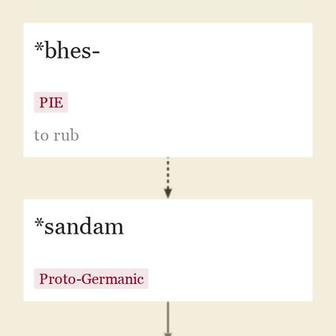psammo-
这个词缀的意思是“沙子”,来自希腊语 psammos “沙子”,与 psamathos 相关(参见 sand(n.))。相关词汇: Psammic。
psammo- 的相关词汇

"细于碎石的水磨砾; 岩石中的细粒子(主要为晶体岩,尤指石英); 海滩、沙漠或海床的材料; " 古英语词语 sand,源自原始日耳曼语言 *sandam (源头同样包括老挝船塞语 sandr,古弗里斯兰语 sond,中古荷兰语 sant,荷兰语 zand,德语 Sand),与希腊语词语 psammos "沙子"; 拉丁语词语 sabulum “粗砂”有亲缘关系(后者是意大利语 sabbia 和法语 sable 的源头)。据说该单词来自于带后缀的“PIE root *bhes-”的词形,但 de Vaan 称拉丁语来自于一个宿语单词,Beekes 则提出 psammos “不太确定的前希腊语 *sam-'沙子, 泥土'”。
历史上, gravel 和 sand 之间的区别并不明显。在古英语中, Sand 在引用不可计数性和不稳定性时具有比喻意义。虽然这是一个一般的日耳曼语词汇,但在哥特语中并没有确切的出现,在此意义上使用了 malma,与老高地德语 melm “灰尘”,瑞典城市名称 Malmö 的第一个元素(第二个元素意为“岛”)以及拉丁语 molere “碾磨”有关。
自古英语以来,“沙”就像比喻性的无数性。常常用于“海岸的,发现于沙滩上”的复合词中。老美国口语中“坚毅,耐力,勇气”等意义约于1867年,尤其在 have sand in (one's) craw 中广泛应用。Sands,“由沙子组成的地区或区域”,于15世纪中期出现。
"plant or animal thriving in sandy places," 1881 (in plural psammophiles, "Proceedings of the Geologists' Association," vol. vi, p. 413, London), 1870s in German and French; see psammo- "sand" + -phile "one that loves." Related: Psammophilic.
[Mr. Lees] might surely have shown his consideration for non-classical mortals by a less profuse use of words like dysgeogenous, eugeogenous, xerophiles, hygerphiles, psammophiles, and so forth. [from review of Frederic Arnold Lees' "The Flora of West Yorkshire" in the Sheffield and Rotherham Independent, April 6, 1888]